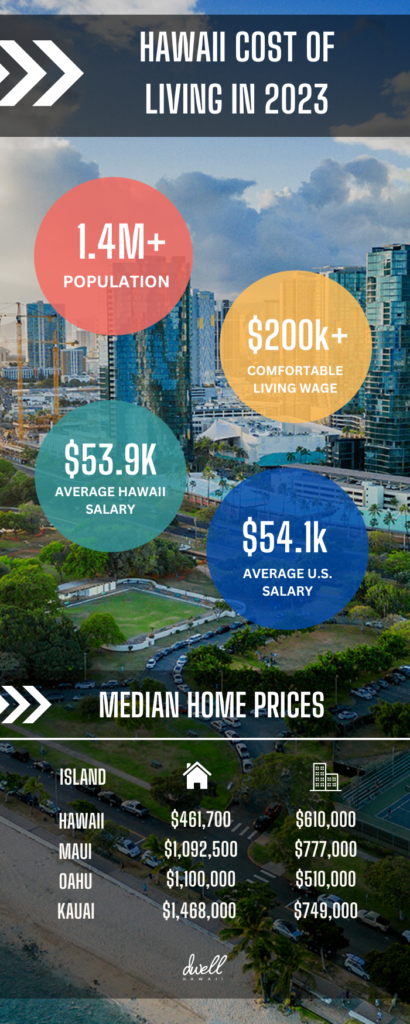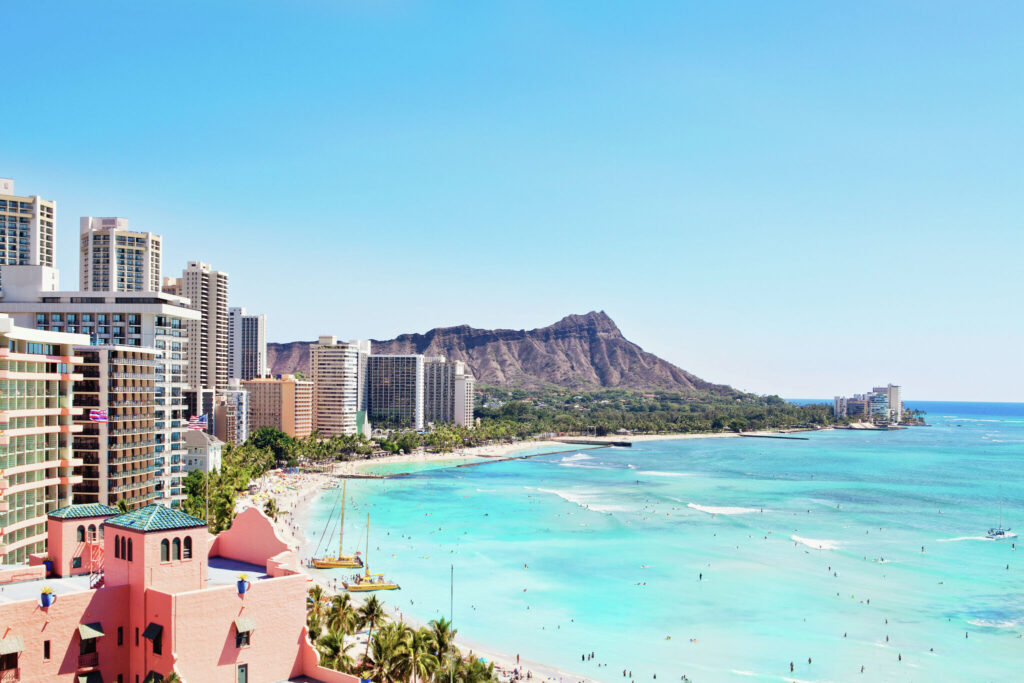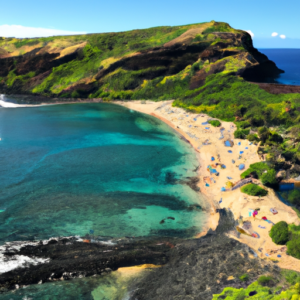If you’ve ever dreamed of sipping cocktails on pristine beaches and wandering through lush jungles, then you’ve probably considered a trip to Hawaii. However, there’s one question that may have held you back: is Hawaii very expensive? This article aims to provide a helpful overview of the cost of living, accommodation, and activities in Hawaii, giving you a clearer picture of what to expect when planning your tropical getaway.

This image is property of qph.cf2.quoracdn.net.
Cost of Living
Hawaii is often perceived as an expensive place to live, and while it is true that certain aspects of daily life can be costly, it is not necessarily as expensive as some may think. Let’s break down the cost of living in Hawaii into different categories to get a clearer picture.
Housing
Housing costs in Hawaii can vary significantly depending on the island and location. Popular areas like Honolulu and Maui tend to have higher housing prices, while more remote or rural areas may offer more affordable options. Renting a one-bedroom apartment in a desirable neighborhood can range from $1,500 to $3,000 per month, while purchasing a home can have a median price of around $600,000. It’s important to research and compare prices before making any housing decisions.
Food
When it comes to food, Hawaii offers a wide variety of options to suit every budget. Eating out at restaurants can be expensive, particularly in touristy areas where prices may be higher. However, exploring local markets and street food vendors can provide affordable and delicious alternatives. Buying groceries and cooking your own meals can also help save money in the long run.
Transportation
Transportation costs can vary depending on your mode of transportation and the distance you need to travel. Owning a car in Hawaii may come with additional expenses such as higher gas prices and maintenance due to the island’s terrain. Car rentals are available, but it’s important to compare prices and book in advance. Public transportation options like buses can be an affordable way to get around, especially in more urban areas.
Utilities
Utilities in Hawaii, including electricity, water, and internet, can be comparable to the mainland United States. However, it’s important to note that the cost of electricity may be higher due to the state’s reliance on imported fuel. Taking steps to conserve energy and water can help keep utility bills manageable.
Healthcare
Healthcare costs in Hawaii can be relatively high compared to other states. It is a good idea to have health insurance to cover any unexpected medical expenses. Hawaii does offer public health coverage programs for low-income residents, and it’s important to explore all options and research healthcare providers to find the best fit for your needs.
Tourist Attractions
One of the main reasons people visit Hawaii is its breathtaking natural beauty and unique attractions. Let’s explore some of the must-see tourist attractions on the islands.
National Parks
Hawaii is home to several stunning national parks, each offering its own distinct beauty. Haleakala National Park on Maui boasts a massive volcanic crater and stunning hiking trails, while Hawaii Volcanoes National Park showcases the world’s most active volcano, Kilauea. The beauty and diversity of these parks are truly awe-inspiring.
Beaches
Hawaii is renowned for its world-class beaches. From the iconic Waikiki Beach in Honolulu to the secluded shores of Lanikai Beach on Oahu, there is a beach for everyone. The crystal-clear turquoise waters, soft white sand, and lush surroundings make Hawaii’s beaches an unforgettable experience.
Volcanoes
Hawaii’s volcanic landscapes are a testament to the earth’s raw power. Volcanoes like Mauna Loa and Kilauea have shaped the islands over millions of years and continue to captivate visitors with their beauty and intrigue. Exploring these volcanic wonders through guided tours or hiking trails offers a glimpse into the island’s geological history.
Hiking Trails
Hawaii’s diverse terrain provides ample opportunities for hiking enthusiasts. From the challenging Kalalau Trail on Kauai’s Na Pali Coast to the family-friendly Manoa Falls Trail on Oahu, there are trails suitable for all skill levels. Each hike presents an opportunity to witness stunning vistas, lush rainforests, and hidden waterfalls.

This image is property of i0.wp.com.
Accommodation Options
Finding the perfect place to stay in Hawaii is an important aspect of your visit. Let’s explore some popular accommodation options available on the islands.
Hotels
Hawaii is famous for its luxurious hotels catering to visitors from around the world. Whether you’re looking for a five-star resort with breathtaking ocean views or a budget-friendly hotel with basic amenities, there are numerous options to choose from. Hotels often provide convenient services such as restaurants, pools, and proximity to popular tourist attractions.
Resorts
Resorts in Hawaii offer guests a complete vacation experience with amenities like spas, golf courses, and multiple dining options. These lavish retreats can be found on each island and cater to those seeking relaxation and indulgence. While some resorts can be quite expensive, special deals and packages are often available, making a luxurious stay more affordable.
Vacation Rentals
Renting a vacation home or condominium can provide more space, privacy, and a home-away-from-home experience. Websites and agencies offer a wide range of options from cozy beachfront cottages to luxurious oceanview condos. Vacation rentals are particularly popular for families or larger groups who prefer the convenience of a fully equipped kitchen and separate bedrooms.
Hostels
If you’re a budget-conscious traveler or looking to meet fellow adventurers, hostels can be an excellent choice. Hawaii’s hostels offer dormitory-style accommodation, communal areas, and often organize social activities for guests. This is a great option for solo travelers or those seeking a more laid-back and sociable atmosphere.
Food and Dining
Hawaii is a melting pot of diverse cultures, and its culinary scene reflects this rich heritage. From upscale restaurants to local markets and street food, there is something to satisfy every palate.
Restaurants
Hawaii boasts a myriad of restaurants serving various cuisines, including traditional Hawaiian, Japanese, Chinese, and American. Fine dining establishments showcase the freshest seafood and locally sourced ingredients, while casual eateries offer classic comfort foods like plate lunches and loco mocos. Trying the local favorites like poke (raw fish salad) and kalua pig (pit-roasted pork) is a must.
Local Markets
Exploring local markets in Hawaii is a feast for the senses. Apart from fresh produce and seafood, these markets offer a chance to sample delicious Hawaiian snacks like spam musubi and malasadas (Portuguese fried doughnuts). Additionally, farmers’ markets are a great place to purchase locally sourced fruits, vegetables, and homemade treats.
Street Food
For an authentic taste of Hawaii, head to the streets and try some delicious street food. Food trucks and roadside vendors offer a wide range of options, from shave ice and plate lunches to ahi poke bowls and loco mocos. The fusion of flavors found in Hawaiian street food is sure to tantalize your taste buds without breaking the bank.

This image is property of assets.site-static.com.
Transportation
Getting around Hawaii requires careful consideration of the available transportation options. Here are a few ways to navigate the islands.
Car Rental
Renting a car in Hawaii provides the flexibility of exploring at your own pace. It allows you to reach more remote areas and access various attractions more easily. However, keep in mind that renting a car can be expensive, especially during peak tourist seasons. It’s advisable to book in advance and compare prices from different rental agencies to secure the best deal.
Public Transportation
Public transportation, particularly buses, is an affordable option for traveling around the islands. The Oahu bus system provides extensive coverage throughout the island, and similar services are available on other islands as well. Buses are a convenient and cost-effective way to get to popular tourist destinations, major shopping centers, and local attractions.
Taxis and Rideshares
Taxis and rideshare services like Uber and Lyft are available in Hawaii, but their availability may be more limited compared to major cities on the mainland. Taxis can be expensive, especially for longer trips, and rideshare prices can vary depending on demand. It’s a good idea to compare prices and estimate fares before choosing this mode of transport.
Shopping
Finding the perfect souvenirs and indulging in some retail therapy is a delightful part of any vacation. Hawaii offers a range of shopping opportunities to suit different tastes and budgets.
Souvenirs
Bringing back a piece of Hawaii is a wonderful way to remember your trip. Souvenir shops can be found in popular tourist areas and offer items like t-shirts, keychains, traditional Hawaiian jewelry, and hula implements. Supporting local artisans and businesses by purchasing locally made souvenirs is a great way to take home a piece of Hawaiian culture.
Luxury Brands
For those seeking high-end designer brands, Hawaii offers numerous luxury shopping centers and boutiques. Waikiki’s Luxury Row, for example, showcases globally renowned brands like Gucci and Chanel. Explore these upscale shopping destinations for luxury fashion, accessories, and cosmetics, but be prepared for higher price tags.
Local Products
Discovering unique local products is one of the joys of traveling to Hawaii. From macadamia nuts and Kona coffee to Hawaiian-made clothing and skincare products enriched with local ingredients, there are plenty of authentic Hawaiian treasures to explore. Look for farmers’ markets, boutique shops, and locally owned stores to find these hidden gems.

This image is property of s.hdnux.com.
Entertainment and Activities
Beyond its natural beauty, Hawaii offers an array of entertainment and activities for visitors to enjoy. Here are some popular options to consider.
Luau Shows
Attending a traditional Hawaiian luau is an experience not to be missed. These events showcase Hawaiian music, hula dances, and cultural performances while treating guests to a feast of local delicacies. Immerse yourself in the warm hospitality and vibrant spirit of Hawaii through traditional music, dance, and culinary delights.
Boat Tours
Exploring Hawaii’s stunning coastlines and marine life is best done through boat tours. Whether it’s a scenic catamaran cruise, a thrilling whale watching excursion, or a snorkeling trip to colorful coral reefs, there is a boat tour for every interest. Savor the beauty of the Pacific Ocean and witness breathtaking sunsets from the comfort of a boat.
Water Sports
Hawaii is a paradise for water sports enthusiasts. Surfing, paddleboarding, kayaking, and snorkeling are just a few of the activities available in these crystal-clear waters. Lessons and rentals are readily available, making it possible for individuals of all skill levels to enjoy the thrill of riding the waves or exploring marine life up close.
Cultural Events
Immerse yourself in Hawaii’s vibrant cultural traditions by attending local events and festivals. From the annual Aloha Festivals celebrating Hawaiian music, dance, and history to the Merrie Monarch Festival, showcasing world-renowned hula dancers, there are numerous opportunities to experience and appreciate the rich heritage of the islands.
Local Culture and Traditions
Hawaii is deeply rooted in its unique culture and traditions. Understanding and appreciating these aspects can enhance your experience on the islands.
Hula Dance
Hula is the traditional dance of Hawaii, and it embodies the spirit of the islands. Attending a hula performance or even participating in a hula class can offer insight into this beautiful art form. Hula tells stories through graceful movements and is deeply connected to Hawaiian history and mythology.
Aloha Spirit
The Aloha Spirit is a core value in Hawaiian culture, encompassing love, compassion, and harmony. Experiencing the Aloha Spirit can be as simple as exchanging a warm smile and greeting with locals, embracing the laid-back lifestyle, and respecting the land and its people. Embracing this spirit can truly enhance your time in Hawaii.
Lei Greetings
Lei greetings are a traditional Hawaiian welcome gesture. Upon arrival at airports or hotels, visitors are often greeted with a fresh flower lei, symbolizing friendship and hospitality. Embrace this island tradition and be prepared to offer a warm “mahalo” (thank you) in return.
Hawaiian Language
Taking the time to learn a few basic Hawaiian words and phrases can go a long way in showing respect for the local culture. Simple greetings like “aloha” (hello) and “mahalo” (thank you) are widely known, and locals appreciate the effort to learn and use the Hawaiian language.

This image is property of assets.site-static.com.
Job Opportunities
For those considering a move to Hawaii or an extended stay, it’s essential to consider job opportunities and the cost of living.
Industries
Hawaii’s major industries include tourism, hospitality, healthcare, education, and the military. Tourism plays a significant role in the state’s economy, offering a wide range of job opportunities in hotels, restaurants, and attractions. The healthcare sector also provides numerous job openings, particularly in nursing and allied health professions.
Average Salaries
Salaries in Hawaii can vary depending on the industry and location. It’s important to research average salaries in your desired field to determine whether it aligns with the cost of living. While some salaries may be higher than the national average, it’s essential to consider the higher costs of housing, transportation, and other expenses in Hawaii.
Cost of Living Considerations
When considering job opportunities in Hawaii, it’s crucial to analyze the cost of living. Housing costs, groceries, healthcare, and transportation are all factors that impact the overall cost of living. Balancing job opportunities with the affordability of daily life is essential to ensure financial stability and a comfortable lifestyle.
Budget and Money Saving Tips
While Hawaii offers incredible experiences, it’s still important to be mindful of your budget. Here are some tips to help you prioritize and save money during your visit.
Travel Off-Season
Visiting Hawaii during off-peak seasons can significantly reduce the cost of accommodations and flights. The months of April, May, September, and October tend to offer more affordable prices and fewer crowds. Exploring less popular islands and avoiding major holidays can also help stretch your budget.
Cook Your Own Meals
Eating out at restaurants can be costly, so consider cooking your own meals as much as possible. Take advantage of local markets and grocery stores to purchase fresh ingredients and prepare delicious meals in your accommodation. This not only saves money but also allows you to experience the flavors of the islands in a more authentic way.
Use Public Transportation
Opting for public transportation, such as buses, can be a cost-effective way to get around the islands. Most islands have reliable bus systems that cover popular tourist areas and major attractions. Utilizing public transportation also reduces the stress of finding parking and eliminates the need for rental car expenses.
By considering these budgeting tips and making conscious choices, you can fully embrace the wonders of Hawaii without breaking the bank. Remember to prioritize your interests and make the most of the affordable and free activities available on the islands. With careful planning, you can create unforgettable memories without sacrificing your financial well-being.
